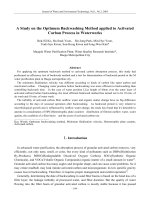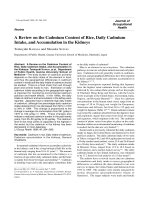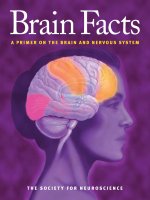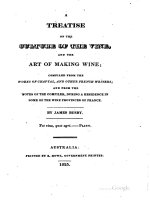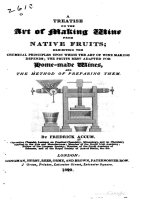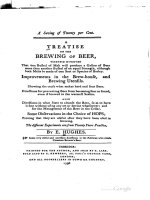A review on the cd content of rice daily cd intake and accumulation in the kidneys
Bạn đang xem bản rút gọn của tài liệu. Xem và tải ngay bản đầy đủ của tài liệu tại đây (51.42 KB, 6 trang )
J Occup Health 1998; 40: 264–269
Journal of
Occupational
Health
A Review on the Cadmium Content of Rice, Daily Cadmium
Intake, and Accumulation in the Kidneys
Tomoyuki KAWADA and Shosuke SUZUKI
Department of Public Health, Gunma University School of Medicine, Maebashi, Japan
Abstract: A Review on the Cadmium Content of
Rice, Daily Cadmium Intake, and Accumulation in
the Kidneys: Tomoyuki K
AWADA,
et al.
Department
of Public Health, Gunma University School of
Medicine—The body burden of cadmium primarily
depends on the daily intake of the element in food,
and thus the geographical differences in cadmium
content in foods and the daily intake of cadmium should
be studied. There is a food chain from soil through
plant and animal foods to man. Estimation of daily
cadmium intake according to the geographical region
is important for monitoring environmental cadmium
pollution and health effects. In the 1990s, the daily
intake of cadmium and accumulation in the kidney were
reported. Japanese have a relatively high daily intake
of cadmium, although the percentage daily cadmium
intake obtained from rice decreased from 50% in 1970
to 34% in 1994. This change is proportional to the
change in average rice consumption from 261 g/day in
1970 to 182 g/day in 1994. These changes also
indicate a reduced cadmium burden in the past twenty
years, from 35–50
µ
g/day to 30
µ
g/day. The cadmium
level in the renal cortex of Japanese is the highest in
the world, but the cadmium in the kidney has been
decreasing in most Japanese.
(
J Occup Health 1998; 40: 264–269
)
Key words: Cadmium in rice, Daily intake of cadmium,
Cadmium accumulation in the kidneys, General
inhabitants
In mammals cadmium is known to accumulate exclusively
in the kidneys, and it has a long biological half-life in the
human body, ranging from 10 to 33 years
1, 2)
. The amount
of cadmium that has accumulated in the kidneys is a
function of age and/or daily cadmium intake, and the latter
is mainly from food, beverages and smoking
2–5)
. Cadmium
in drinking water and in the atmosphere contributes little
Received May 22, 1998; Accepted July 7, 1998
Correspondence to: T. Kawada, Department of Public Health,
Gunma University School of Medicine, Showa, Maebashi 371-8511,
Japan
to the daily intake of cadmium
6)
.
Man is an element in an ecosystem. The cadmium
pathways to man are soil-plant-animal-man and soil-plant-
man. Cadmium-rich soil generally results in cadmium-
rich food, and geographical differences have been reported
in daily cadmium intake and cadmium accumulation in
the kidneys
2, 4, 7, 8)
.
Earlier investigators reported finding that Japanese
have the highest renal cadmium levels in the world,
followed by rice-eating ethnic groups such as the people
of Thailand, Hong Kong and Taiwan, with the lowest
levels in people in the United States, Switzerland, India,
Nigeria, and Rwanda-Burundi
2, 9)
. Data for cadmium
concentrations in the human renal cortex range from an
average of 10 to 30
µ
g/g wet weight for Europeans,
Americans and Africans, but from 65 to 115
µ
g/g wet
weight for Japanese (Table 1)
10–16)
. Renal cadmium content
is governed by cadmium absorbed from the digestive tract
and respiratory organs that comes from food, beverages
and cigarettes, which originate in the soil. The cadmium
content of plants varies from place to place on the earth.
Baseline studies on environmental monitoring of cadmium
is needed, but the data are very limited
2, 3)
.
Suzuki and Lu previously estimated the daily cadmium
intake in Japan, the United States and Indonesia by food
and feces analysis. The daily cadmium intake of two men
in Tokyo averaged 48.2 and 46.9
µ
g/day/person based on
a 30-day another meal method, versus 35.9 and 36.0 based
on a 30-day feces analysis
17)
. The daily cadmium intake
in Houston, Texas, ranged from 11.9 to 18.2 based on
food analysis and a market-basket survey
18)
. The daily
cadmium intake on Java Island, Indonesia, was estimated
to be 17.2 based on food analysis of a 5-day menu
19)
.
The authors have reviewed recent data on cadmium
accumulation and daily intake to assess geographical
differences, in addition the data obtained in our own
surveys in Japan, the United States and Indonesia from
1972 to 1985. The samples were mainly measured by
atomic absorption spectrophotometry (flame or
flameless). The target subjects were male and female
Review
265Tomoyuki KAWADA, et al.: Cadmium Intake and Its Accumulation
inhabitants in non-cadmium-polluted areas and their
average age was 50 years.
The purpose of this review was to identify trends in
cadmium exposure in ordinally inhabitants, especially net
cadmium intake by ingestion. This will be useful as
baseline data for cadmium intake except via smoking or
occupational exposure.
Geographical differences in the cadmium content
in rice
Many surveys have reported finding showing that rice
produced in Japan contained the highest cadmium levels
among samples collected from several different areas in
the world
20, 21)
. A survey on the cadmium content of rice
in samples from 22 countries by Masironi et al.
21)
revealed
the lowest level, 2 ng/g, in rice from Brazil and the highest
level, 65 ng/g, in rice from Japan. The Japanese
Government’s program to replace polluted rice field soil
is being carried out. Suzuki et al. reported an arithmetic
mean and SD in Indonesian rice of 40 ± 42 ng/g and a
geometric mean of 31 ng/g
22)
. The mean and SD for
cadmium in rice from Spain was 32.2 ± 25.94 ng/g
23)
. In
China, the average value for cadmium in polished rice
from a non-polluted area was 60 ng/g
24)
. These results
show that considerable geographical differences exist in
the cadmium content of rice.
The rice of West Java has been found to have double
the cadmium content of rice from Central and East Java
22)
.
The soil type in West Java is Ultisol, as opposed to Vertisol
in East Java. The soil type in Western Japan is also
Ultisol, and this may explain the higher cadmium levels
25)
.
The cadmium content of soil also differs very much
from place to place, and this may be responsible for the
difference in the amount of rice in plant foods produced
in soil. The correlation between cadmium content in soil
and rice is low within the same area but high between
different areas
26)
.
Daily cadmium intake
There are four ways of estimating of daily cadmium
intake. The first is another meal method or duplicate
portions method. The total diet is usually mixed or
homogenized, and part of it is taken for analysis. The
second method is the market-basket method for
Table 1. Geographical difference in cadmium concentration in the kidney cortex in several countries in
the 1960s, 1970s and 1980s
Country Ref. Age sex Mean (SD) Analytical method
USA 9 29.1 Freeze-dry,emission S
Switzerland 10 31.1 Dry, emission S
Rwanda- 10 9.8 Dry ash, emission S
Burundi
Nigeria 10 23.3 Dry ash, emission S
Indonesia – 46–59 M & F 19.5 (0.33)
G
Wet ash, Flameless AAS
Sweden 15 40–49 Male 19.3 (1.80)
G
Dry ash, Flame AAS
Sweden 15 40–49 Female 25.8 (1.65)
G
Dry ash, Flame AAS
Sweden 15 50–59 Male 15.6 (2.48)
G
Dry ash, Flame AAS
Sweden 15 50–59 Female 21.2 (2.05)
G
Dry ash, Flame AAS
West Germany 11 41–50 Male 23.2
G
Wet ash,Flameless AAS
West Germany 11 51–60 Male 17.5 (1.3)
G
Wet ash, Flameless AAS
West Germany 11 41–50 Female 16.8 (1.3)
G
Wet ash, Flameless AAS
West Germany 11 51–60 Female 12.7 (2.1)
G
Wet ash, Flameless AAS
Japan 12 40–59 Male 87 (37) Flame AAS
Japan 12 40–59 Female 99 (20) Flame AAS
Japan 13 39 (Mean) 58.8 Wet ash, Flame AAS
Japan 14 40–49 85.1 (47.49) Wet ash, Flame AAS
Japan 14 50–59 125.3 (56.74) Wet ash, Flame AAS
Japan 15 40–49 Male 43.2 (1.65)
G
Wet ash, Flame AAS
Japan 15 40–49 Female 82.7 (1.51)
G
Wet ash, Flame AAS
Japan 15 50–59 Male 65.0 (2.17)
G
Wet ash, Flame AAS
Japan 15 50–59 Female 63.2 (1.42)
G
Wet ash, Flame AAS
Japan 16 40–49 Male 114.1 (37.2) Wet ash, Flame AAS
G; Geometric mean and/or geometric standard deviation, S; spectrophotometer
AAS; atomic absorption spectrophotometer
266 J Occup Health, Vol. 40, 1998
individuals and total diet method for populations. Foods
and beverages are sampled and bought in representative
retail shops in the area and analyzed for the element. The
cadmium content of the same food item is averaged and
multiplied by individual food consumption data or by
the national food balance sheet data. The third method is
estimation of daily cadmium intake from daily cadmium
excretion in feces. Daily cadmium in feces equals about
95% of the daily oral cadmium intake
27)
. Approximate
daily cadmium intake is roughly calculated from the feces
data multiplied by a factor of 100/95
28)
. The last method
is estimation by using a nomogram indicating the relation
between the average concentration of cadmium in the
kidneys at age 50 and the average daily cadmium intake
in an area or a country.
Daily cadmium intake is reported to be low in
Germany
29)
, Sweden
30, 31)
, China
32)
and Taiwan
33)
. The
intake values in Croatia
34)
, Finland
35)
and Spain
23)
are
moderate. Most mean values range from 10 to 20
µ
g/
day. Data reported from Korea
36)
and Japan
32, 37)
are high,
ranging from 20 to 30
µ
g/day/person (Table 2). This is
consistent with the moderate accumulation of the element
in the renal cortex of Japanese
2, 38)
.
Cadmium in the renal cortex
The renal cortex is a critical organ in terms of long-
term exposure to cadmium. Cadmium content data for
the renal cortex reported recently have shown the lowest
values in Spain
39)
and Poland
4, 40, 41)
and relatively high
values, exceeding 50
µ
g/g, in Germany
42)
and Sweden
43)
.
In Japan, Koizumi et al. reported 130 and 21
µ
g/g as GM
× ÷ GSD, respectively, from which a geometric mean of
52.2
µ
g/g was calculated
44)
(Table 3). The WHO
recommendation
45)
states that the critical concentration
Table 2. Geographical difference in daily intake of cadmium by duplicate
meal method published in the 1990s
Country Ref. Mean (SD) Analytical method
Spain 23 18.18 Wet ash, Flameless AAS
Germany 29 9.7 (8.1) Dry ash, Flame AAS
Sweden 30 11.1 (4.2) Dry ash, Flame AAS
Sweden 31 12 Flameless AAS
China 32 9.9 (2.33)
G
Wet ash, Flameless AAS
Taiwan 33 10.1 (1.70)
G
Wet ash, Flameless AAS
Croatia 34 17.34 Dry ash, Flame AAS
Finland 35 14.5 (3.1) Flameless AAS
Korea 36 21.2
G
Wet ash, Flameless AAS
Japan 32 32.1 (1.93)
G
Wet ash, Flameless AAS
Japan 37 30.0 (2.09)
G
Wet ash, Flameless AAS
G; Geometric mean and/or geometric standard deviation
AAS; atomic absorption spectrophotometer
Table 3. Geographical difference in cadmium concentration in the kidney cortex
published in the 1990s
Country Ref. Smoke Mean (SD) Analytical method
Poland 4 – 28.5 (1.9)
G
Wet ash, Flame AAS
Spain 39 + & – 14.6 (5.9) Wet ash, Flameless AAS
Poland 40 – 16.5 (1.8)
G
Wet ash, Flame AAS
Poland 41 – 26.3 (23.5) Wet ash, Flame AAS
Germany 42 + & – 55.2 (50) ICP
Sweden 43 – 62.8 Wet ash, Flameless AAS
Japan 44 + & – 52.2
G
Wet ash, AAS*
G; Geometric mean and/or geometric standard deviation
*; Flame or flameless atomic absorption spectrophotometer
Some dissociation existed in daily intake of cadmium and its accumulation in the
kidneys for example in Germany and Sweden.
267Tomoyuki KAWADA, et al.: Cadmium Intake and Its Accumulation
of cadmium in the renal cortex is about 200
µ
g/g. The
standard deviation of the data for Germany is 50, so that
the values in under 1% of the target population exceed
200
µ
g/g.
Comments
The daily cadmium intake and renal cortex cadmium
concentration data over the past quarter of a century are
Fig. 1. Daily intake of cadmium and its concentration in the renal cortex. Over 100
µ
g/g of
cadmium in the renal cortex was also reported in the 1970s and 1980s in Japan.
plotted in Fig. 1. Rice eaters have been said to ingest
about a half or more of their daily cadmium intake from
rice
46)
. The latest data in Japan show that one third of the
daily cadmium intake comes from rice. Compared with
the data for Japan in the 1970s
17, 38, 46)
, which ranged from
35 to 50
µ
g/day, the daily intake of cadmium has
decreased recently. This may be partly attributable to
decreased rice consumption, which averaged 261 g/day
268 J Occup Health, Vol. 40, 1998
in 1970 and 182 g/day in 1994
47)
, in addition to the
elimination of polluted rice from the market and increased
consumption of imported foods.
The criteria for food being a good indicator of cadmium
intake are: large and widespread consumption, ubiquitous
cultivation throughout the world, and easy sampling,
transportation, and conservation
2)
. Rice, wheat, and a
few vegetables, such as carrots, are therefore the best
indicator foods for cadmium. Although the consumption
of rice has been decreasing, e.g., in Japan, daily cadmium
intake can be roughly estimated by analysis of the
cadmium content in the rice people eat. Rice is the best
indicator food for cadmium monitoring in rice-eating
ethnic groups. Sources of daily cadmium intake in non-
rice-eaters are cereals, vegetables and potatoes, although
non-rice-eaters are usually not in the high-risk group for
cadmium intake.
References
1) Ellis KJ, Vartsky D, Zanzi I, Cohn SH, Yasumura S.
Cadmium: in vivo measurement in smokers and
nonsmokers. Science 1979; 205: 323–325.
2) Suzuki S, Koyama H, Hattori T, Kawada T, Rivai IF.
Daily intake of cadmium: an ecological view.
Proceedings of Asia-Pacific Symposium on
Environmental and Occupational Toxicology, 1988:
205–217.
3) Friberg L, Vahter M. Assessment of exposure to lead
and cadmium through biological monitoring: results
of a UNEP/WHO global study. Environ Res 1983; 30:
95–128.
4) Bem EM, Orlowski C, Piotrowski JK, Januszewski K,
Pajak J. Cadmium, zinc, copper, and metallothionein
levels in the kidney and liver of inhabitants of upper
Silesia (Poland). Int Arch Occup Environ Health 1993;
65: 57–63.
5) Nilsson U, Schütz A, Skerfving S, Mattsson S.
Cadmium in kidneys in Swedes measured in vivo using
X-ray fluorescence analysis. Int Arch Occup Environ
Health 1995; 67: 405–411.
6) Nordberg GF, Nordberg M. Biological monitoring of
cadmium. In Clarkson TW, Friberg L, Nordberg GF,
Sager PR eds. Biological monitoring of toxic metals,
Plenum, New York, 1988: 151.
7) Friberg L, Piscator M, Nordberg GF, Kjellström T.
Cadmium in the environment. 2
nd
ed. Boca raton FL:
CRC Press, 1974.
8) López-Artiguez M, Cameán A, González G, Repetto
M. Cadmium concentrations in human renal cortex
tissue (necropsies). Bull Environ Contam Toxicol 1995;
54: 841–847.
9) Perry HM, Tipton IH, Schroeder HA, Steiner RL, Cook
MJ. Variation in the concentration of cadmium in
human kidney as a function of age and geographic
origin. J Chronic Dis 1961; 14: 259–271.
10) Cherry WC. Distribution of cadmium in human tissues.
In: Nriagu JO, ed. In Cadmium in the environment,
Part 2. Health effect. New York: John Willey & Suns,
1981: 69.
11) Hahn R, Ewers U, Jermann E, Freier I, Brockhaus A,
Schlipköter HW. Cadmium in kidney cortex of
inhabitants of North-West Germany: its relationship
to age, sex, smoking and environmental pollution by
cadmium. Int Arch Occup Environ Health 1987; 59:
165–176.
12) Ishizaki A, Fukushima M, Sakamoto M. Contents of
cadmium and zinc of Itai-itai disease patients and
residents of Hokuriku district. Nippon Eiseigaku Zasshi
1971; 26: 268–273 (in Japanese).
13) Sumino K, Hayakawa K, Shibata T, Kitamura S. Heavy
metals in normal Japanese tissues. Amounts of 15 heavy
metals in 30 subjects. Arch Environ Health 1975; 30:
487–494.
14) Tsuchiya K, Seki Y, Sugita M. Cadmium concentrations
in the organs and tissues of cadavers from accidental
deaths. Keio J Med 1976; 25: 83–90.
15) Kjellström T. Exposure and accumulation of cadmium
in populations from Japan, the United States, and
Sweden. Environ Health Perspectives 1979; 28: 169–
197.
16) Kobayashi S. Effect of aging on the concentration of
cadmium, zinc and copper in human kidney. Nippon
Koshu Eisei Zasshi 1983; 30: 27–34 (in Japanese).
17) Suzuki S. and Lu CC. A balance study of cadmium—
an estimation of daily input, output and retained amount
in two subjects. Ind Health 1976; 14: 53–65.
18) Suzuki S. unpublished data.
19) Suzuki S, Hyodo K, Koyama H, Djuangsih N,
Soemarwoto O. Estimation of daily intake of cadmium
from foods and drinks, and from feces at three
kampungs of Java Island. In: Suzuki S, ed. Health
Ecology in Indonesia. Tokyo: Gyosei, 1988: 65–73.
20) Rivai IF, Koyama H, Suzuki S. Cadmium content in
rice and its daily intake in various countries. Bull
Environ Contam Toxicol 1990; 44: 910–916.
21) Masironi R, Koirtyohann SR, Pierce JO. Zinc, copper,
cadmium and chromium in polished and unpolished
rice. Sci Total Environ 1977; 7: 27–43.
22) Suzuki S, Djuangsih N, Hyodo K, Soemarwoto O.
Cadmium, copper, and zinc in rice produced in Java.
Arch Environ Contam Toxicol 1980; 9: 437–449.
23) López-Artiguez M, Soria ML, Cameán A, Repetto M.
Cadmium in the diet of the local population of Seville
(Spain). Bull Environ Contam Toxicol 1993; 50: 417–
424.
24) Cai S, Yue L, Shang Q, Nordberg G. Cadmium
exposure among residents in an area contaminated by
irrigation water in China. Bull World Health Organ
1995; 73: 359–367.
25) Rivai IF, Koyama H, Suzuki S. Cadmium content in
rice and rice field soil in China, Indonesia, and Japan,
with special reference to soil type and daily intake.
Minzoku Eisei 1990; 56: 168–177.
26) Suzuki S, Iwao S. Cadmium, copper, and zinc levels
in the rice and rice field soil of Houston, Texas. Biol
Trace Elem Res 1982; 4: 21–28.
27) Friberg L, Kjellström T, Nordberg GF. Cadmium. In
Friberg L, Nordberg GF, Vouk V eds. Handbook on
269Tomoyuki KAWADA, et al.: Cadmium Intake and Its Accumulation
the toxicology of metals. 2
nd
ed. Vol II, Amsterdam:
Elsevier, 1986: 140.
28) Kowal NE, Johnson DE, Kraemer DF, Pahren HR.
Normal levels of cadmium in diet, urine, blood, and
tissues of inhabitants of the United States. J Toxicol
Environ Health 1979; 5: 995–1014.
29) Müller M, Anke M. Distribution of cadmium in the
food chain (soil-plant-human) of a cadmium exposed
area and the health risks of the general population. Sci
Total Environ 1994; 156: 151–158.
30) Vahter M, Berglund M, Nermell B, Åkesson A.
Bioavailability of cadmium from shellfish and mixed
diet in women. Toxicol Appl Pharmacol 1996; 136:
332–341.
31) Becker W, Kumpulainen J. Contents of essential and
toxic mineral elements in Swedish market-basket diets
in 1987. Br J Nutr 1991; 66: 151–160.
32) Zhang ZW, Moon CS, Watanabe T, Shimbo S, He FS,
Wu YQ, Zhou SF, Su DM, Qu JB, Ikeda M.
Background exposure of urban populations to lead and
cadmium: comparison between China and Japan. Int
Arch Occup Environ Health 1997; 69: 273–281.
33) Ikeda M, Zhang ZW, Moon CS, Imai Y, Watanabe T,
Shimbo S, Ma WC, Lee CC, Guo YL. Background
exposure of general population to cadmium and lead
in Tainan city, Taiwan. Arch Environ Contam Toxicol
1996; 30: 121–126.
34) Sapunar-Postruznik J, Bazulic D, Kubala H, Balint L.
Estimation of dietary intake of lead and cadmium in
the general population of the Republic of Croatia. Sci
Total Environ 1996; 177: 31–35.
35) Louekari K, Valkonen S, Pousi S, Virtanen L. Estimated
dietary intake of lead and cadmium and their
concentration in blood. Sci Total Environ 1991; 105:
87–99.
36) Moon CS, Zhang ZW, Shimbo S, Watanabe T, Moon
DH, Lee CU, Lee BK, Ahn KD, Lee SE, Ikeda M.
Dietary intake of cadmium and lead among the general
population in Korea. Environ Res 1995; 71: 46–54.
37) Watanabe T, Nakatsuka H, Shimbo S, Iwami O, Imai
Y, Moon CS, Zhang ZW, Iguchi H, Ikeda M. Reduced
cadmium and lead burden in Japan in the past 10 years.
Int Arch Occup Environ Health 1996; 68: 305–314.
38) Tsuchiya K. Cadmium in human urine, feces, blood,
hair, organs, and tisues. In Tsuchiya K ed. Cadmium
studies in Japan: a review. Tokyo: Kodansha, 1978:
37–43.
39) Torra M, To-Figueras J, Brunet M, Rodamilans M,
Corbella J. Total and metallothionein-bound cadmium
in the liver and the kidney of a population in Barcelona
(Spain). Bull Environ Contam Toxicol 1994; 53: 509–
515.
40)
´
Bem EM, Piotrowski JK, Turzynska E. Cadmium, zinc,
and copper levels in the kidneys and liver of the
inhabitants of north-eastern Poland. Pol J Occup Med
Environ Health 1993; 6: 133–141.
41)
/
Orlowski C, Piotrowski JK, Kubów M. The levels of
cadmium, zinc and copper in the renal cortex and liver
of the inhabitants of the copper basin. Int J Occup Med
Environ Health 1996; 9: 255–263.
42) Müller I, Helmers E, Barchet R, Schweinsberg F.
Cadmium concentration in the renal cortex of kidney
tumor patients and controls. J Trace Elem Electrolytes
Health Dis 1994; 8: 173–176.
43) Hardell L, Wing AM, Ljungberg B, Dreifaldt AC,
Degerman A, Halmans G. Levels of cadmium, zinc
and copper in renal cell carcinoma and normal kidney.
Eur J Cancer Prev 1994; 3: 45–48.
44) Koizumi N, Hatayama F, Sumino K. Problems in the
analysis of cadmium in autopsied tissues. Environ Res
1994; 64: 192–198.
45) Friberg L, Kjellström T, Nordberg GF. Cadmium. In:
Friberg L, Nordberg GF, Vouk V, eds. Handbook on
the toxicology of metals. 2
nd
ed. Vol II. Amsterdam:
Elsevier, 1986: 166–169.
46) Iwao S. Cadmium, lead, copper and zinc in food, feces
and organs of humans. Interrelationships in food and
feces and interactions in the liver and the renal cortex.
Keio J Med 1977; 26: 63–78.
47) Ministry of Agriculture, Forestry and Fisheries. Food
Balance Sheet, Minister’s Secretariat, 1995. (This table
is based upon FAO’s preparation guide. Period is one
year from April 1st to March 31st of the following year.
Total population used in calculating supplies per capita
is 125 034 thousand (as of Oct. 1st, 1994) estimated
by Statistics Bureau, Management and Coordination
Agency).
